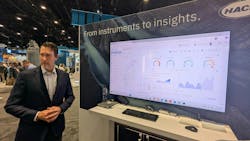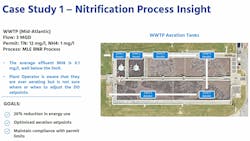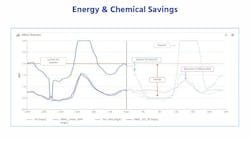Aquatic Informatics unveils predictive tools for WIMS Process Manager during WEFTEC 2025
Just four months ago at AWWA ACE25, Aquatic Informatics teased new capabilities for WIMS Process Manager and its predictive tools have now arrived.
Speaking to Wastewater Digest from the Aquatic Informatics booth at WEFTEC, Dave Rutowski highlighted the key features of the WIMS software and how its predictive tools will help wastewater systems balance their priorities while achieving their goals. WIMS historically has been a repository for system data, but with its new features, it can now simulate real-world conditions of the future using a digital twin.
A digital twin is a virtual replica of a physical system, and in the case of WIMS it uses existing data and physical parameter information from the utility to provide predictive analysis across a number of charts.
“Digital twin is a term that’s thrown around a lot in the industry, so we want to first define what we call it. It has to be based on a physical system. You can’t just make up numbers. It’s very much based on the size of the plant and the size of every tank and pipe,” said Dave Rutowski, global sales and training enablement manager for Aquatic Informatics.
The previously mentioned charts can be hand-selected depending on the user’s needs, meaning a utility administrator could have a dashboard entirely different from the operator who needs the finer details. Learn more about the baseline features of WIMS in our coverage from AWWA ACE25.
Rutowski showed off an example case study for how WIMS Process Manager could be used to manage competing priorities, improve energy efficiency and give utility managers, supervisors and operators peace of mind when they leave for the day. Consider, for example, a Mid-Atlantic system with 3 MGD flow using an MLE BNR process that has permit limits of 12 mg/l of TN and 1 mg/l of NH4. It is trying to achieve the following goals:
- Reduce energy use by 20%
- Optimize aeration setpoints
- Remain compliant with permits
The forecasting and prediction tools of WIMS are based on industry standards such as SUMO; this model, he noted, is one of three used by every engineer in the market. As such, it can forecast when there are expected spikes in NH4 or TN to operate the plant in a proactive sense.
More-over, the dashboard shows a prediction for the future of treatment parameters so that operators can adjust for anticipated high or low load periods in advance. Rutowski said this would be particularly useful for smaller systems as it can give a solo operator the peace of mind that things are running properly and efficiently over the weekend. And if something were to go wrong, alerts could reach that operator via email or text in an emergency.
About the Author
Bob Crossen
Bob Crossen is the vice president of content strategy for the Water and Energy Groups of Endeavor Business Media, a division of EndeavorB2B. EB2B publishes WaterWorld, Wastewater Digest and Stormwater Solutions in its water portfolio and publishes Oil & Gas Journal, Offshore Magazine, T&D World, EnergyTech and Microgrid Knowledge in its energy portfolio. Crossen graduated from Illinois State University in Dec. 2011 with a Bachelor of Arts in German and a Bachelor of Arts in Journalism. He worked for Campbell Publications, a weekly newspaper company in rural Illinois outside St. Louis for four years as a reporter and regional editor. Crossen can be reached at [email protected].



